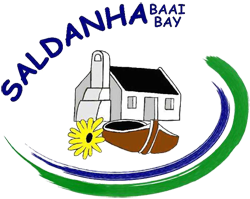Kathu is a town in South Africa, and the iron ore capital of the Northern Cape province. Its name means "town under the trees", after the Camel Thorn forest it is situated in. The phrase "the town under the trees" was coined by an engineer working in the town in the early-1990s as part of a tourist marketing drive, together with the accompanying graphic. It was intended to be a marketing slogan. The meaning of the word "Kathu" has anecdotically been attributed to a porridge brewed by the local population from the powder found in the pods of the Camel Thorn trees.

Paternoster is one of the oldest fishing villages on the West Coast of South Africa. It is situated 15 km north-west of Vredenburg and 145 km north of Cape Town, at Cape Columbine between Saldanha Bay and St Helena Bay. The town covers an area of 194.8 hectare and has approximately 1883 inhabitants.

Saldanha Bay Municipality is a local municipality located within the West Coast District Municipality, in the Western Cape province of South Africa. As of 2011, it had a population of 99,193. Its municipality code is WC014.

Port Nolloth is a town and small domestic seaport in the Namaqualand region on the northwestern coast of South Africa, 144 kilometres (89 mi) northwest of Springbok. It is the seat of the Richtersveld Local Municipality.

The West Coast is a region of the Western Cape province in South Africa and is bordered by the Atlantic Ocean on the west and the Swartland region on the east.

The West Coast National Park lies 88 km (55 mi) north of Cape Town in the Western Cape province of South Africa. The park is found inside of the Cape West Coast Biosphere Reserve, part of the UNESCO Man and the Biosphere Programme. It is bordered by the Atlantic Ocean on the west and the R27 coastal road, and runs from the town of Yzerfontein in the south, up to the Langebaan Lagoon. The park is particularly well known for its bird life and for the spring flowers which occur in the months from August to September, especially in the Postberg flower reserve section of the park. The park, with the islands in Saldanha Bay, has been identified by BirdLife International as an Important Bird Area. The park was proclaimed in 1985, and is 36,259.8 hectares (140.000 sq mi) in size.

Langebaan is a town in the Western Cape province of South Africa on the eastern shore of Langebaan Lagoon.

The Sishen–Saldanha railway line, also known as the Ore Export Line (OREX), is an 861-kilometre-long (535 mi) heavy-haul railway line in South Africa. It connects iron ore mines near Sishen in the Northern Cape with the port at Saldanha Bay in the Western Cape. It is used primarily to transport iron ore (60 million tonnes per year) and does not carry passenger traffic.

Saldanha, also known as Saldanha Bay, is a town of 21,636 people, located 110 kilometres (70 mi) north of Cape Town on the northern shore of Saldanha Bay, in the Western Cape province of South Africa. Its situation as a natural sheltered harbour has led to development as a port for the export of iron ore from Sishen in the Northern Cape, which is transported on the Sishen–Saldanha railway line. The port is one of the largest exporting ports of ore in the whole of Africa, and it is able to handle ships as large as 200 000 tons deadweight. Saldanha Bay is named after António de Saldanha, captain of a vessel in Albuquerque's fleet which visited South Africa in 1503.

SAS Somerset was a Bar-class boom defence vessel of the South African Navy, now preserved as a museum ship in Cape Town. Formerly HMS Barcross, it operated in Saldanha Bay, was transferred to South Africa Naval Forces during World War II, and was purchased by South Africa in 1947.

Hopefield is a settlement in West Coast District Municipality in the Western Cape province of South Africa on the R45 between Malmesbury and Vredenburg. The town lies east of Saldanha Bay and Langebaan, 40 km (25 mi) southeast of Vredenburg and 120 km (75 mi) north of Cape Town.

The South African Railways Class 9E, Series 1 of 1978 is an electric locomotive.

The South African Railways Class 9E, Series 2 of 1982 is an electric locomotive.

Miller's Point is a headland and stretch of protected coastline in South Africa. It is located about 4 kilometres (2.5 mi) south of Simon's Town on the road to Cape Point.

The South African Railways Class 34-400 of 1973 is a diesel-electric locomotive.

The South African Railways Class 34–900 of 1980 is a diesel-electric locomotive.
Dingleton is a town in Northern Cape, South Africa.
The Sishen mine is a large iron mine located in central South Africa in Kathu, Northern Cape. Sishen represents one of the largest iron ore reserves in South Africa and in the world having estimated reserves of 2.43 billion tonnes of ore grading 58.6% iron metal.
The marine protected areas of South Africa are in an area of coastline or ocean within the exclusive economic zone (EEZ) of the Republic of South Africa that is protected in terms of specific legislation for the benefit of the environment and the people who live in and use it. An MPA is a place where marine life can thrive under less pressure than unprotected areas. They are like underwater parks, and this healthy environment can benefit neighbouring areas.

Schaapeneiland is an island in Saldanha Bay on West Coast, Western Cape, South Africa.




















